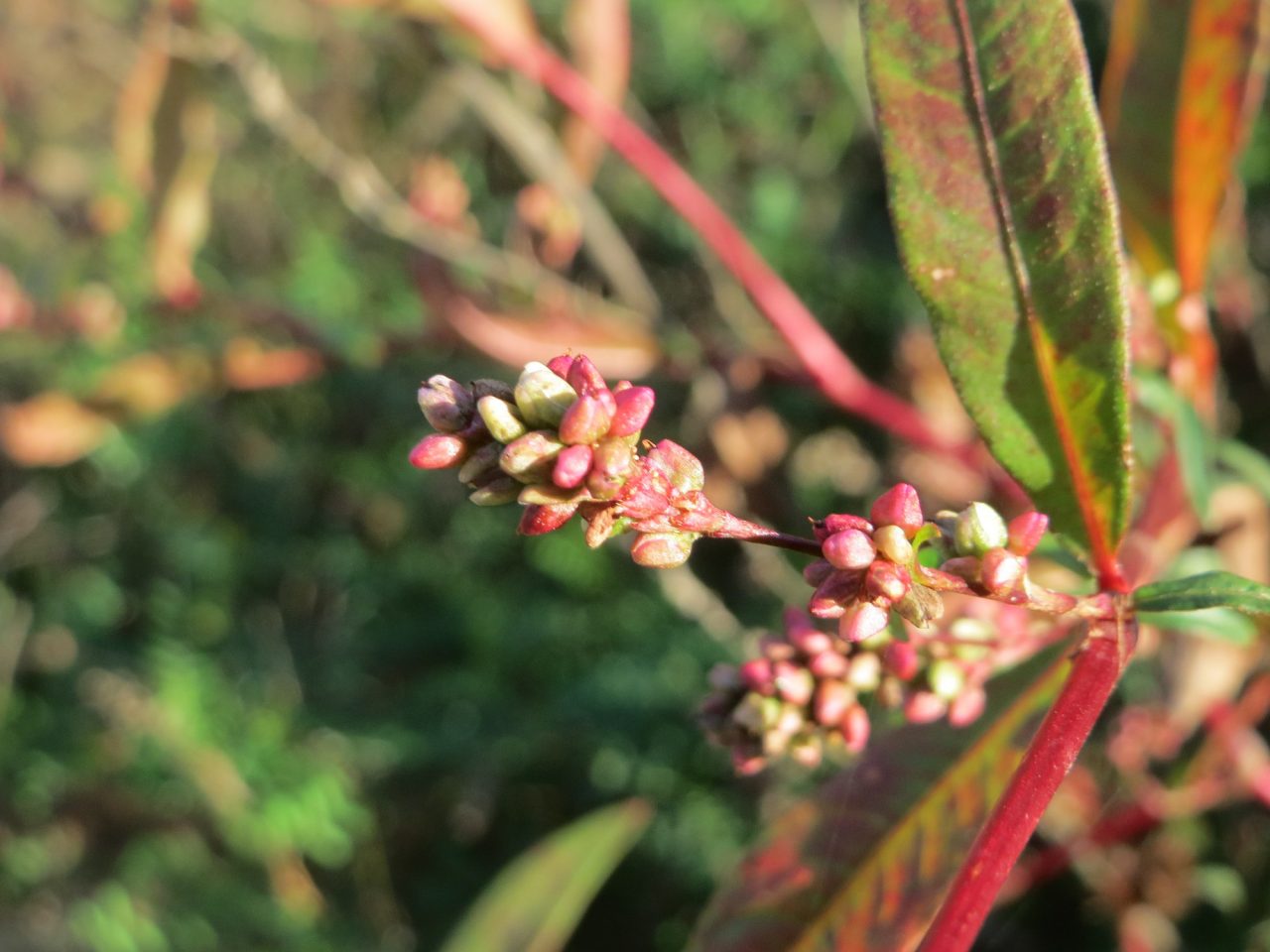Leaves of pale smartweed (Persicaria/Polygonum lapathifolia) are commonly used in ethnomedicine to treat stomach disorders, fever, disorders of kidneys, kidney stones and urinary tract infections. It is commonly associated with antiviral, antifungal, astringent, hepatoprotective, anthelmintic, antibacterial, anti-emetic, anti-inflammatory and antioxidant properties. 1

Taste: Pleasant, not bitter
Toxic constituents: Chalcones {flavokawain B (2’-hydroxy-4’,6’-dimethoxychalcone); 2’,4’-dihydroxy-3’,6’-dimethoxychalcone; lapathone; angelafone; valafolone; melafolone}
Other constituents are represented by tannins (gallic acid), flavonoids (pinostrobin, quercetin, kaempferol, quercitrin gallate, taxifolin, quercitrin, isoquercitrin, astragalin, kaempferol-3-O-galactoside, hyperoside, 5,8-dimethoxy-7-hydroxyflavanone, lapathinol), phenylpropanoid esters of sucrose (vanicosides, lapathosides A-D), hydropiperoside
Toxicity
Chalcones, which are characterized by low solubility in water, but good solubility in polar solvents such as ethanol, are the principal toxic compounds. Chalcones containing methoxy and hydroxyl groups have been linked with hepatotoxicity. Studies have also found that they may be directly cytotoxic towards cells of liver, modifying mitochondrial membrane potential of hepatocytes. 1
Flavokawain B is one of the hepatotoxic constituents from kava root, which is known for causing oxidative stress of liver and depletion of liver GSH accompanied with inhibition of NF-kB transcription activity. 2
Cattle that grazed pale smartweed (among other plants) experienced photosensitization and hepatotoxicity, ultimately resulting in liver failure. 3
Research suggests that liver is the main target of the toxicity. Hepatoprotective herbs that replenish glutathione levels seem like the best course of action upon intoxication.
Potential benefits
- Vanicoside B and lapathoside A inhibit Epstein-Barr virus and carcinogenesis (primarily skin) 4
- Lapathoside D- active against cervical cancer 5
- Pinostrobin also possesses anti-ulcer, anti-inflammatory, antiviral (active against HSV-1 and dengue virus), antioxidant, antimicrobial, anti-venom, anticancer and antiparasitic effects 6
- Pinostrobin rapidly penetrates cells and enters the nucleus causing apoptosis of leukemia cells (cancer prevention) 7
- Quercitrin gallate inhibits production of NO and iNOS suggesting it may have anti-inflammatory and antioxidant effects 8,9
- Pinostrobin may also be active against cervical cancer and fibrosarcoma modulating GSH/NO/ROS pathways 10
- Flavonoids possess diuretic effects, explaining some of its uses for treatment of kidney disorders
Final verdict: This plant is quite under-researched so bear that in mind before using it. Water infusions should not be harmful to you, but under no circumstances should you use this herb as an alcoholic tincture. You may experience some positive effects when using a water infusion of this herb, but there are still concerns about the solubility of all the chalcones and their concentrations. Even though they possess poor solubility in water, it’s very likely that overdoses can cause the concentration to increase. I would definitely not recommend eating this plant.
References
1. Kubínová, R. & Navrátilová, A. Biological activities of polyphenols from Polygonum lapathifolium (Actividades biológicas de polifenoles de Polygonum lapathifolium). (2014).
2. Zhou, P. et al. Flavokawain B, the hepatotoxic constituent from kava root, induces GSH-sensitive oxidative stress through modulation of IKK/NF-kappaB and MAPK signaling pathways. FASEB J. 24, 4722–32 (2010).
3. Lugton, I. & Woolacott, J. Liver necrosis and photosensitisation in cattle after eating Persicaria lapathifolia (pale knotweed) and Persicaria orientalis (Prince’s feather). Aust. Vet. J. 92, 62–64 (2014).
4. Takasaki, M., Konoshima, T., Kuroki, S., Tokuda, H. & Nishino, H. Cancer chemopreventive activity of phenylpropanoid esters of sucrose, vanicoside B and lapathoside A, from Polygonum lapathifolium. Cancer Lett. 173, 133–138 (2001).
5. Panda, P. et al. Synthesis and antitumor activity of lapathoside D and its analogs. Eur. J. Med. Chem. 53, 1–12 (2012).
6. Patel, N. K., Jaiswal, G. & Bhutani, K. K. A review on biological sources, chemistry and pharmacological activities of pinostrobin. Nat. Prod. Res. 30, 2017–2027 (2016).
7. Smolarz, H. D., Mendyk, E., Bogucka-Kocka, A. & Kockic, J. Pinostrobin – An Anti-Leukemic Flavonoid from Polygonum lapathifolium L. ssp. nodosum (Pers.) Dans. Zeitschrift für Naturforsch. C 61, 64–68 (2006).
8. Kim, B. H. et al. Down-regulatory effect of quercitrin gallate on nuclear factor-κB-dependent inducible nitric oxide synthase expression in lipopolysaccharide-stimulated macrophages RAW 264.7. Biochem. Pharmacol. 69, 1577–1583 (2005).
9. Jo, H.-Y. et al. The inhibitory effect of quercitrin gallate on iNOS expression induced by lipopolysaccharide in Balb/c mice. J. Vet. Sci. 9, 267 (2008).
10. Jaudan, A., Sharma, S., Malek, S. N. A. & Dixit, A. Induction of apoptosis by pinostrobin in human cervical cancer cells: Possible mechanism of action. PLoS One 13, e0191523 (2018).
Featured image by Andreas Rockstein, available here

Leave a Reply